Specialty paper offers high durability and texture, enhancing detail and color vibrancy in fine art. Rice paper provides a lightweight, absorbent surface ideal for traditional ink and watercolor techniques, emphasizing fluidity and softness.
Table of Comparison
| Feature | Specialty Paper | Rice Paper |
|---|---|---|
| Material Composition | Varies (cotton, hemp, linen blends) | Natural fibers from rice straw or mulberry bark |
| Texture | Smooth to textured, depending on type | Delicate, fibrous, and slightly translucent |
| Durability | High; resistant to aging and wear | Moderate; prone to tearing if handled roughly |
| Absorbency | Controlled; designed for various mediums (ink, watercolor) | Highly absorbent; ideal for ink wash and traditional painting |
| Usage in Art | Mixed media, watercolor, printmaking, calligraphy | Traditional Asian painting, calligraphy, paper crafts |
| Cost | Moderate to high, depending on quality | Generally low to moderate |
| Availability | Widely available globally | Specialty stores, limited in some regions |
Overview: Specialty Paper vs Rice Paper
Specialty paper for art is engineered with unique textures, weights, and finishes to enhance various artistic mediums such as watercolor, acrylic, or mixed media, offering durability and color vibrancy. Rice paper, traditionally made from natural fibers like mulberry or bamboo, is prized for its lightweight, semi-translucent qualities, and delicate texture, making it ideal for calligraphy, traditional Asian ink painting, and delicate layering techniques. Artists select specialty paper when needing robustness and diverse handling properties, while rice paper suits projects requiring softness, absorbency, and a natural, organic aesthetic.
Material Composition and Origins
Specialty paper, often crafted from cellulose fibers such as cotton or wood pulp, offers a textured and durable surface ideal for various art mediums, originating primarily from Western papermaking traditions. Rice paper, traditionally made from the pith of the Tetrapanax papyrifer plant or mulberry fibers, boasts a delicate, lightweight structure essential in East Asian calligraphy and painting. Both materials differ significantly in fiber composition and cultural origins, influencing their absorbency, texture, and suitability for specific artistic techniques.
Texture and Surface Qualities
Specialty paper offers a diverse range of texture options, including smooth, rough, and embossed surfaces that enhance detailed artwork and mixed media applications. Rice paper is known for its delicate, fibrous texture and translucent quality, providing a unique surface that absorbs ink and paint differently, ideal for traditional Asian brushwork and calligraphy. Artists select specialty paper for its consistent texture and durability, while rice paper is favored for its natural, organic feel and subtle surface irregularities that contribute to dynamic visual effects.
Absorbency and Ink Behavior
Specialty paper designed for art applications typically features controlled absorbency to prevent ink bleed and maintain sharp, vibrant lines, making it ideal for detailed ink work and mixed media. Rice paper, known for its high absorbency, allows ink to spread and blend, creating soft, organic textures favored in traditional Asian brush painting but less suited for precision. Understanding the absorbency and ink behavior differences helps artists select the right paper to achieve their desired effects and maintain color integrity.
Compatibility with Art Mediums
Specialty paper offers superior compatibility with diverse art mediums such as watercolor, acrylic, and ink due to its textured surface and absorbency tailored for artistic techniques. Rice paper, while delicate and ideal for traditional Asian ink brush painting and calligraphy, often struggles with heavy paints and thick applications, limiting its use with mediums like acrylics or oils. Artists must consider the specific medium and desired effect, as specialty paper supports layering and blending, whereas rice paper excels in fine, detailed strokes and fluid washes.
Durability and Longevity
Specialty paper designed for art offers superior durability and longevity compared to rice paper, as it typically contains acid-free fibers and is engineered to resist yellowing and deterioration over time. Rice paper, while valued for its delicate texture and traditional aesthetic, is more prone to tearing, fading, and damage from environmental factors such as moisture and UV light. Artists seeking archival-quality results prioritize specialty paper to ensure their work remains vibrant and intact for decades.
Visual Appeal and Finish
Specialty paper offers a rich texture and vibrant color retention, making it ideal for detailed art that requires sharp contrasts and a polished finish. Rice paper provides a delicate, translucent quality with a natural matte surface, enhancing traditional brushwork and subtle ink gradients. Artists choose specialty paper for consistent smoothness and saturation, whereas rice paper is preferred for its organic feel and unique visual softness.
Cost and Availability
Specialty paper for art varies widely in price depending on texture, weight, and brand, with options often more costly but readily available in art supply stores. Rice paper typically costs less and is widely accessible in Asian markets and online, prized for its delicate texture ideal for calligraphy and watercolor. The choice between specialty and rice paper hinges on budget constraints and the specific artistic use, balancing cost-effectiveness with material qualities.
Recommended Uses in Art Projects
Specialty paper offers diverse textures and weights suitable for detailed illustrations, watercolor, and mixed media projects, making it ideal for professional artists seeking durability and vibrant color retention. Rice paper, prized for its delicate, translucent quality and smooth surface, is recommended for traditional Asian brush painting, calligraphy, and layered collage work that benefits from its lightweight nature. Both materials enhance artistic expression, with specialty paper preferred for robust, multi-layered creations and rice paper favored for subtle, ethereal effects.
Choosing the Right Paper for Your Art
Specialty paper offers diverse textures and weight options tailored for techniques like watercolor, printmaking, and mixed media, enhancing durability and color vibrancy. Rice paper, traditionally made from mulberry fibers, provides a lightweight, translucent surface ideal for calligraphy and delicate ink washes, emphasizing subtle brushwork. Selecting the right paper depends on the medium, desired texture, and longevity requirements of your artwork.

Infographic: Specialty paper vs Rice paper for Art
 azmater.com
azmater.com